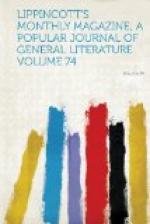protected by law in France at the fall of the First
Napoleon than in Great Britain. Nevertheless,
the movement had begun in the latter country forty
years before. A generation had passed since the
battle of Culloden, and the island was at length indissolubly
and efficiently one. It shared fully in the intellectual
impulse of the day. Victorious in all its latest
struggles and freed from all sources of internal danger,
it might naturally have been expected to enter at
once on a career of improvement more marked than in
the case of its neighbors. It is not easy to
assign reasons for failure in this respect, unless
we seek them in disgust at the subsequent dismemberment
and disturbance of the empire by the fruits of popular
agitations in America, Ireland and France. The
reaction due to such causes was probably sufficient
to defeat all liberal efforts. The leading English
writers of the Revolutionary period were strong Tories.
Such were Johnson, the Lake poets after their brief
swing to the opposite extreme, and Scott. All
these except the first belong as well to the time of
successful reform, and Johnson may be claimed by the
eighteenth century; which serves to illustrate the
blight cast upon British literature by the prolonged
resistance of British statesmen to the prevailing current—a
resistance which took its keynote from the dying recantation
and protest of the Whig Chatham.
The opening of the epoch, then, was as marked in Great
Britain as elsewhere. Only in special fields
she afterward fell behind, and lost something like
half the century. In others she kept abreast,
or even in advance.
Criticism was not content to exercise its new powers
and apply its newly-framed laws exclusively in the
investigation of any branch of philosophy. It
brought them to bear upon the arts. The discovery
of the buried cities of Campania aided in attracting
renewed attention to the art-stores of Italy, ancient
and modern. The principles of taste and beauty
which they illustrated were searchingly analyzed and
carefully explained. Painting and sculpture began
slowly to emit their rays through the eclipse of more
than a century. The allied art shared in this
second and secondary renaissance. Haydn was in
full fruit, Mozart ripening, and Music watched, in
the cradle of Beethoven, her budding Shakespeare.
A fourth Teuton was studying the symphonies of the
spheres; and within the first five years of the century,
while the “crowning mercy” of Yorktown
was maturing, a planet that had never before dawned
on the eye of man took its place with the ancient six,
and “swam into the ken” of Herschel.




